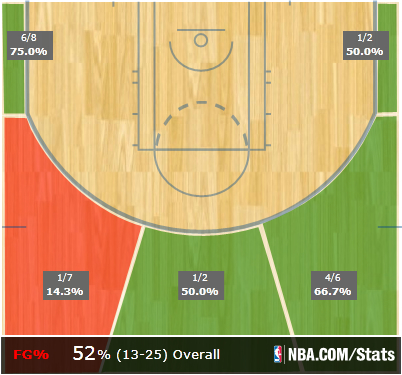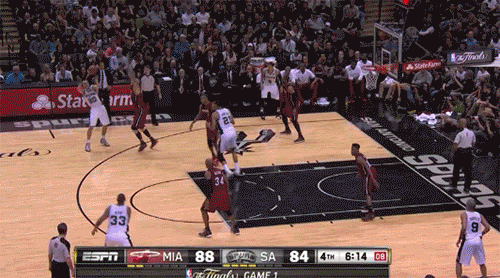How the Spurs shot so well from beyond the arc in Game 1
With so much focus on LeBron James and his leg cramp, it's easy to miss one key determinant to the Heat's loss in Game 1 - the Spurs' three-point shooting.
As a whole, the San Antonio shot 13-for-25 from deep. Leading the way were guards Danny Green and Manu Ginobili, who both sunk three triples apiece. San Antonio hit all six of their three-point attempts in the fourth quarter en route to a 36-point outburst in the final frame.
A cursory glance at their shot chart from beyond the arc exposes one obvious trend. The Spurs were on fire from the corners, shooting a combined 7-for-10.

San Antonio's accuracy from the corner is not surprising. The Spurs lead all teams in the league in three-point percentage from the corner this playoffs, canning 47.7 percent of their attempts.
However, the trend is particularly worrisome for the Heat, as the Spurs' corner threes were a symptom of the Heat's aggression on defense.
It's no secret that the Heat are at their best when playing "small-ball". To compensate for the downgrade in size, the Heat often collapse on bigs in the perimeter, as they're weary of conceding open looks to the opposing frontline.
This strategy of helping towards the basket comes with a cost, especially when said help comes from the corners. For example, consider this triple from Green.

Spurs forward Tim Duncan found himself with the smaller Heat forward Rashard Lewis covering him in the paint. Duncan easily pins Lewis on his back, which opens himself for an easy entry pass. Heat guard Dwyane Wade notices this, and takes a few precautionary steps into the paint to help at the rim. The result is a wide open three from Wade's man in the corner.
Unfortunately for the Heat, there is no simple solution if they want to keep playing smaller lineups. Without enough rim protectors at the paint, Miami has to choose between guarding the paint, or the three-point line.
The Heat relied on quicker rotations and jumping passing lanes through three quarters to combat San Antonio's size advantage. The strategy yielded turnovers early on, but when the Spurs' passes became crisper, the Heat were toast.
More worrisome, the Heat couldn't stop San Antonio anywhere in Game 1. In addition to their success on three-pointers, the Spurs also shot 74.2 percent at the rim. In particular, the starting front-court of Tim Duncan and Tiago Splitter shot a combined 14-for-16 from the field, with their attempts coming largely at the rim.
Having LeBron back will help, as his strength and speed allows him to defend both on the perimeter and in the paint. However, given the outcome of Game 1, the Heat have plenty of reasons to rethink their defensive strategy.